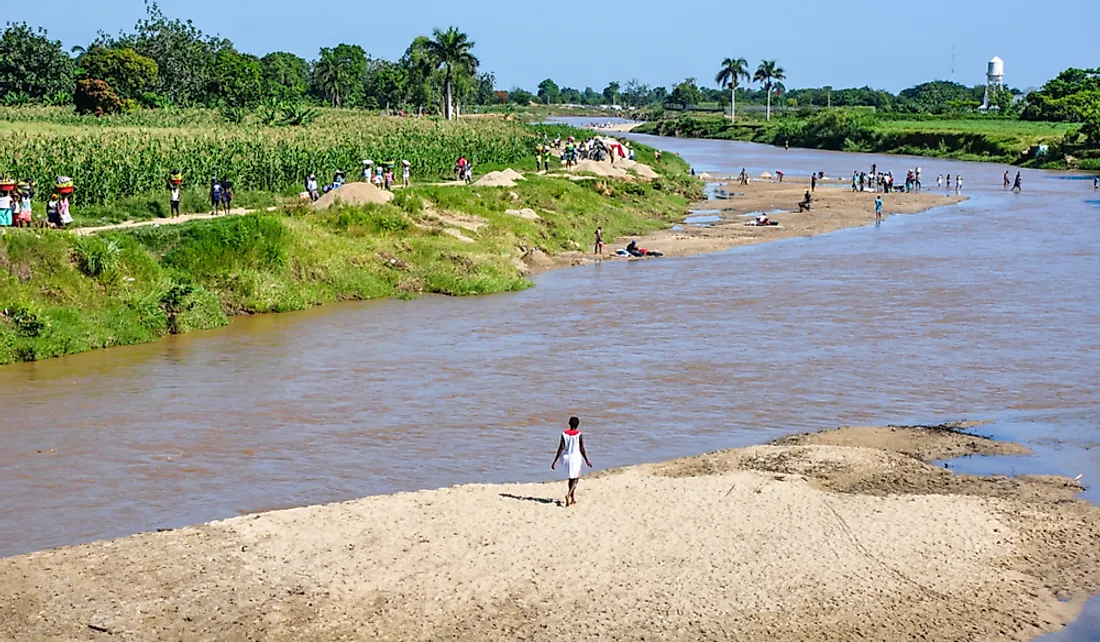What Countries Border Haiti?

The Republic of Haiti is one of the Caribbean countries that occupy the western three-eighths of Hispaniola Island. The country is positioned between the Caribbean Sea and the Atlantic Ocean. Haiti covers a total area of 10,714 square miles; 10,641 square miles is land and 73 square miles is water. It also has a large coastline, making it prone to hurricanes. Haiti shares a land border with the Dominican Republic, which occupies the rest of Hispaniola in the east. To the west and the south, it is surrounded by the Caribbean Sea and to the north by the Atlantic Ocean. Haiti also shares maritime borders with the Caribbean countries of Cuba, Jamaica, and the Bahamas. Cuba lies 50 miles to the west of Haiti’s across the Windward Passage in the northern peninsula, a strait that connects the Atlantic to the Caribbean. Jamaica is located across the Jamaica Channel 120 miles west of the southern peninsula. The Great Inagua Island comprising of the Bahamas lies 70 miles north of Haiti. It also claims sovereignty over Navassa Island, a deserted offshore islet 35 miles west of the Jamaican tunnel.
Land Border: Dominican Republic
The Dominican Republic is the only country sharing a land border with Haiti. The countries share the Hispaniola Island of the Caribbean. Despite sharing a land border, the two countries are worlds apart. Diplomatic relationships between the two nations have been complex following their colonial history and cultural differences. The tumultuous history began during the colonial days when conflict erupted between Spain and France in regards to who would control the island. The conflict was resolved in 1691 when the island was split into two countries. Until the mid-20th century, the economies of the two countries were comparable, but since then, the Dominican economy has been growing while that of Haiti diminishes.
Cross-border relationships exist between the two countries in the areas of health, infrastructure, and business. Many Haitians travel to the Dominican Republic in search of employment opportunities as laborers. Political conflicts between the two governments have led to a lack of legal framework to address migration patterns between the two countries. Racial discrimination is high in the Dominican Republic and most immigrants of Haiti descent residing in the country face discrimination in the healthcare system in the country. After the 2010 earthquake, a large number of Haitians migrated to the Dominican Republic to escape the devastating effects of the earthquake. However, most did not return to their country and live in Dominican albeit lacking the legal papers. They are widely blamed for increasing unemployment and crime rates in the country.
Maritime Borders
Jamaica
Haiti shares a maritime border with Jamaica, which lies 190 miles west of the southern peninsula. Since independence, Jamaica has always been a popular destination and safe haven for Haitian leaders and politicians. While Haiti established diplomatic relations with Jamaica through an embassy in Kingston in 1981, Jamaica only established an honorary consulate with no corresponding mission in Haiti. In 2012, the Haitian Ministry of Foreign Affairs cited a strained relationship between the two countries. Haiti further went ahead to close its embassy and withdrew agents from in Jamaica stating non-reciprocity from the Jamaican counterparts. While Haiti has always opened its doors to Jamaica by allowing its citizens to travel to the country without Visas, Haitians are not allowed to travel to Jamaica without valid consent.
What is left is a mutually beneficial relationship between the two nations established by the Caricom nations. Nonetheless, Jamaica promises to support Haiti in its endeavors to gain socioeconomic stability, peace, and prosperity even without resident missions. Strangely, Jamaica believes that the establishment of a resident mission in Haiti would greatly facilitate the deepening and strengthening of relations between the two nations.
Cuba
Cuba is located 50 miles west of Haiti’s northern peninsula across the windward strait. The two countries had diplomatic ties until 1959 when the relationship broke during the dictatorship of Francois "Papa Doc" Duvalier. Duvalier made the move after Organization of American States ordered all its member states to break all ties with the government of Fidel Castro. The ties we restored in 1998 during the Hurricane George that struck Haiti. The Cuban government moved in with a multifaceted agreement to help the country in the medical field.
Cuba has adopted a two-way approach to help Haiti in healthcare. They arranged to maintain doctors in the country to operate under the guidelines Haiti. Cuba also offered to train Haiti doctors with the promise of returning to their country to take the place of the Cuban doctors. This immensely improved the healthcare system in the country, which was the worst in the Americas. Cuba also liberalized its immigration laws allowing Haitians to travel into the country and establish trading relationships. It is estimated that there are over one million Haitians living in Cuba.
Great Inagua Island (Bahamas)
Since independence, the Bahamas has always had special diplomatic and economic relationships with Haiti. The strong diplomatic relationship was established upon the arrival of the first Counsel from Haiti to the Bahamas. The relationship was strengthened because of its close proximity to the southern islands of the Bahamas. Prior to 1800, the French referred to Haiti as the pearl of the Antilles as it supplied food items to the Bahamas. After the Revolution, many Haitians migrated to the Bahamas for economic and education reasons. Today, the Bahamas have an enormous opportunity to benefit economically from Haiti.











